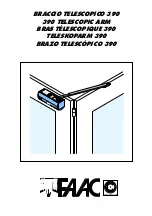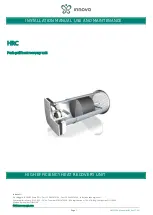
18
improved heat transfer. These mixtures are usually used on
ferrous materials.
TIG welding
In TIG (Tungsten Inert Gas) welding the electric arc is
struck between a non-consumable electrode (pure tungsten
or an alloy) and the work piece in an atmosphere protected
by an inert gas (argon).
The TIG lift-arc process is struck by contact. A low short-
circuit welding current is set to limit the tungsten inclusion
on the work piece. This process does not guarantee a weld
of high quality at the start of the bead.
To completely prevent the tungsten being included, you
must not let the electrode touch the piece to be welded.
However you use a start-up with high frequency (HF)
discharge, that allows striking of the electric arc at a
distance.
To improve the quality of the final part of the welding bead,
you can control the descent ramp of the welding current
and the post-gas time.
TIG welding is used for welding that must have an optimum
finished appearance with limited post-welding work. This
requires correct preparation and cleaning of the edges to
be welded. The rods of consumable material must have
mechanical properties comparable to those of the material
to be welded. Pure argon is always used as the protective
gas, in quantities which vary according to the welding
current chosen.
According to the type of welding that you need to obtain
and the type of material to be welded, you can choose the
welding polarity:
Direct polarity:
The most commonly used polarity which permits welding
most materials is direct polarity, which means that the TIG
torch is connected to the P1 socket and the earth clamp to
the positive socket P2. This polarity leads to limited wear of
the electrode, since most of the heat is concentrated on the
piece to be welded.
This polarity is used for welding materials with high thermal
conductivity, such as copper, but also for welding steel for
which red-coloured thoriated tungsten (2% thorium)
electrodes are recommended. The diameter of the
electrode varies according to the welding current chosen.
Inverse polarity:
Inverse polarity, on the other hand, allows you to weld
alloys covered with a refractory oxide coating (whose
melting point is higher than the metal), e.g. aluminium (and
its alloys) and magnesium. As opposed to direct polarity,
here you attach the TIG torch to the positive socket, P2,
and the earth clamp to the socket, P1. This polarity puts the
electrode under a great amount of heat, with the resultant
wear on it. For this reason, you can only carry out welding
at low currents.
MMA welded with coated electrode:
To obtain good welds, it is necessary to weld on clean
metal pieces, which are free of rust or other contaminating
agents. In preparing the edges to be welded, take into
account the thickness, type of joint, position of weld and the
requirements of the project. Normally the edges are
prepared in a “V” shape; but with thicker items, it is
recommended to have "X" shaped edges (back weld) or "U"
shaped edges (no back weld).
The manufacturers of the electrodes specify the optimum
welding current for each type of electrode. The type of
electrode to be used depends on the thickness of the
material to be welded and on its position.
Insert the chosen electrode into the electrode holder. To
strike the electric arc, rub the electrode against the material
to be welded connected to the earth (ground) clamp. Once
the arc is struck, lift the electrode holder slowly to the
normal welding distance.
To strike the arc better, an initial current is supplied which is
higher (hot-start) compared to the welding current. The
electrode on melting deposits in the form of drops onto the
piece to be welded and its outer coating is consumed
supplying the shielding gas for the welding. To facilitate the
fluidity of the welding arc, while the drops are coming off,
which can cause a short circuit between the electrode and
the weld pool, a momentary increase in the welding current
(arc-force) is given, thus preventing the arc from going out.
If the electrode stays stuck to the piece to be welded, there
is an anti-stick function that, after a certain short-circuit time,
cuts off the power to the generator. Thus you can detach
the electrode without damaging it.
When the coating electrodes are used, you need to remove
the dross from the welding after every pass.
Содержание XuperMIG-2500
Страница 1: ...1 11 20 30 39...



































